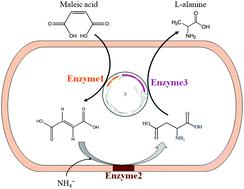当前位置:
X-MOL 学术
›
Green Chem.
›
论文详情
Our official English website, www.x-mol.net, welcomes your feedback! (Note: you will need to create a separate account there.)
Biosynthesis of L-alanine from cis-butenedioic anhydride catalyzed by a triple-enzyme cascade via a genetically modified strain
Green Chemistry ( IF 9.8 ) Pub Date : 2021-09-01 , DOI: 10.1039/d1gc02244j Ruizhi Cui 1 , Zhongmei Liu 1 , Puyi Yu 1 , Li Zhou 1 , Zhemin Zhou 1
Green Chemistry ( IF 9.8 ) Pub Date : 2021-09-01 , DOI: 10.1039/d1gc02244j Ruizhi Cui 1 , Zhongmei Liu 1 , Puyi Yu 1 , Li Zhou 1 , Zhemin Zhou 1
Affiliation

|
In industry, L-alanine is biosynthesized using fermentation methods or catalyzed from L-aspartic acid by aspartate β-decarboxylase (ASD). In this study, a triple-enzyme system was developed to biosynthesize L-alanine from cis-butenedioic anhydride, which was cost-efficient and could overcome the shortcomings of fermentation. Maleic acid formed by cis-butenedioic anhydride dissolving in water was transformed to L-alanine via fumaric acid and L-asparagic acid catalyzed by maleate isomerase (MaiA), aspartase (AspA) and ASD, respectively. The enzymatic properties of ASD from different origins were investigated and compared, as ASD was the key enzyme of the triple-enzyme cascade. Based on cofactor dependence and cooperation with the other two enzymes, a suitable ASD was chosen. Two of the three enzymes, MaiA and ASD, were recombinant enzymes cloned into a dual-promoter plasmid for overexpression; another enzyme, AspA, was the genomic enzyme of the host cell, in which AspA was enhanced by a T7 promoter. Two fumarases in the host cell genome were deleted to improve the utilization of the intermediate fumaric acid. The conversion of whole-cell catalysis achieved 94.9% in 6 h, and the productivity given in our system was 28.2 g (L h)−1, which was higher than the productivity that had been reported. A catalysis-extraction circulation process for the synthesis of L-alanine was established based on high-density fermentation, and the wastewater generated by this process was less than 34% of that by the fermentation process. Our results not only established a new green manufacturing process for L-alanine production from cis-butenedioic anhydride but also provided a promising strategy that could consider both catalytic ability and cell growth burden for multi-enzyme cascade catalysis.
中文翻译:

顺丁烯二酸酐生物合成 L-丙氨酸由三酶级联催化通过转基因菌株
在工业上,L-丙氨酸使用发酵法生物合成或由天冬氨酸β-脱羧酶(ASD)催化从L-天冬氨酸。在这项研究中,开发了一种三酶系统从顺式丁烯二酸酐生物合成L-丙氨酸,具有成本效益,可以克服发酵的缺点。顺丁烯二酸酐溶于水形成的马来酸通过富马酸和L转化为L-丙氨酸-天冬氨酸分别由马来酸异构酶 (MaiA)、天冬氨酸酶 (AspA) 和 ASD 催化。研究和比较了不同来源的 ASD 的酶学特性,因为 ASD 是三酶级联反应的关键酶。基于辅因子依赖性和与其他两种酶的合作,选择了合适的 ASD。三种酶中的两种,MaiA 和 ASD,是克隆到双启动子质粒中用于过表达的重组酶;另一种酶 AspA 是宿主细胞的基因组酶,其中 AspA 被 T 7启动子增强。宿主细胞基因组中的两个延胡索酸酶被删除以提高中间体富马酸的利用率。全细胞催化转化率在 6 小时内达到 94.9%,我们系统给出的生产率为 28.2 g (L h) -1,这高于已报告的生产率。建立了基于高密度发酵合成L-丙氨酸的催化-萃取循环工艺,该工艺产生的废水不到发酵工艺废水的34%。我们的研究结果不仅为顺式丁烯二酸酐生产L-丙氨酸建立了新的绿色制造工艺,而且为多酶级联催化同时考虑催化能力和细胞生长负担提供了一种有前景的策略。
更新日期:2021-09-03
中文翻译:

顺丁烯二酸酐生物合成 L-丙氨酸由三酶级联催化通过转基因菌株
在工业上,L-丙氨酸使用发酵法生物合成或由天冬氨酸β-脱羧酶(ASD)催化从L-天冬氨酸。在这项研究中,开发了一种三酶系统从顺式丁烯二酸酐生物合成L-丙氨酸,具有成本效益,可以克服发酵的缺点。顺丁烯二酸酐溶于水形成的马来酸通过富马酸和L转化为L-丙氨酸-天冬氨酸分别由马来酸异构酶 (MaiA)、天冬氨酸酶 (AspA) 和 ASD 催化。研究和比较了不同来源的 ASD 的酶学特性,因为 ASD 是三酶级联反应的关键酶。基于辅因子依赖性和与其他两种酶的合作,选择了合适的 ASD。三种酶中的两种,MaiA 和 ASD,是克隆到双启动子质粒中用于过表达的重组酶;另一种酶 AspA 是宿主细胞的基因组酶,其中 AspA 被 T 7启动子增强。宿主细胞基因组中的两个延胡索酸酶被删除以提高中间体富马酸的利用率。全细胞催化转化率在 6 小时内达到 94.9%,我们系统给出的生产率为 28.2 g (L h) -1,这高于已报告的生产率。建立了基于高密度发酵合成L-丙氨酸的催化-萃取循环工艺,该工艺产生的废水不到发酵工艺废水的34%。我们的研究结果不仅为顺式丁烯二酸酐生产L-丙氨酸建立了新的绿色制造工艺,而且为多酶级联催化同时考虑催化能力和细胞生长负担提供了一种有前景的策略。


























 京公网安备 11010802027423号
京公网安备 11010802027423号